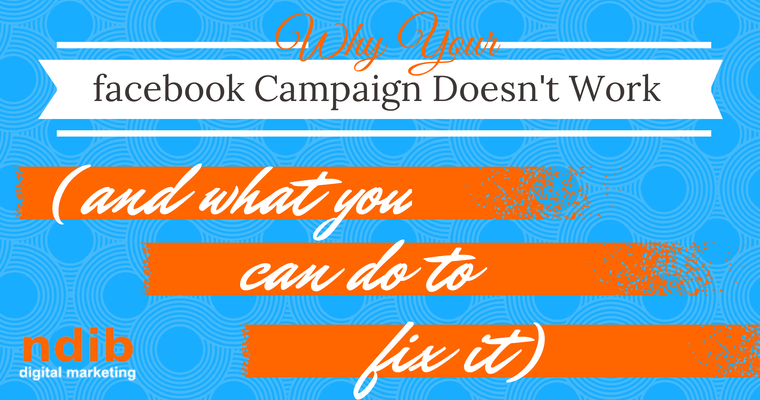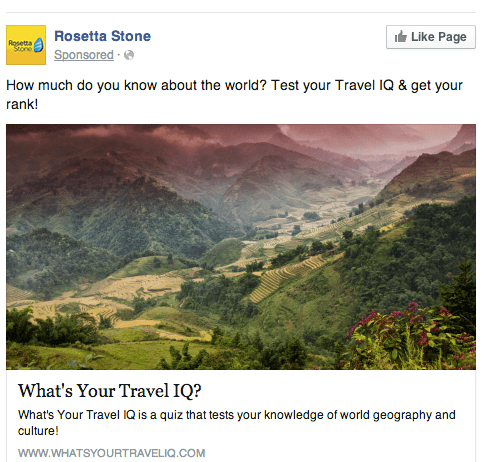

Facebook is the future of Internet advertising. Or so you might have heard.
While it seems that everyone else’s ads are generating revenue, your ads sit there on the side of the page—unclicked like an ignored friend request from that person you barely even knew from high school.
What is going on with your Facebook campaign? Your ads go unnoticed, people bounce off of your landing page, and your value proposition seems to offer no value.
You wonder: Do companies actually make money with Facebook ads? Is this all a lie?
As you read case studies about success with Facebook ads, you may want todrag Mark Zuckerberg by the hoodie to your office and show him what exactly is going on with your particular campaign: The ROI is not case study worthy, in fact your ROI isn’t even positive.
If this sounds like you, then you are missing a vital link about how advertising on Facebook works. Here are the most common reasons why your Facebook campaign is failing.
You are Advertising on Facebook Like it’s a Search Engine
As someone who reads Search Engine Journal, you probably know how to make Internet advertising produce the business results you want on Google AdWords. AdWords has been around since 2000, so you have had some time to experiment with the system and learn how to use it effectively for your specific business model. You know about keeping your ad Groups tight, using negative keywords, and sending users to the right landing page.
However, when you take what you learned from AdWords and try applying it on Facebook the results are disappointing. This is because you are trying to advertise on Facebook like it is a search engine, while your potential customers are using Facebook like the social network it is.
Facebook Users Browse While Google Users Search With a Goal in Mind
People use social channels like Facebook with different intent than they use search engine channels like Google.
You need to match the intent of the channel with your advertising campaign’s strategy.
When users search on Google they have a specific intent in mind, which often boils down to knowing, going, or doing. Each one of these intents is a type of question which requires a specific answer:
- Knowing looks for more information on a product, service, or person.
- Going looks for a destination (like typing in Search Engine Journal into the search bar).
- Doing looks for a place to make a transaction or other conversion.
If everything works as it should, Google is there to provide the link to the exact answer the user is looking for. Your ad on Google should be as relevant to that specific intent as possible. In fact, when you get down to it, Google’s whole ad system is based on relevancy to your specific query, Google just calls it a quality score.
If you read Google’s own help section it states:
“having a high quality score means that our system thinks that your ad and landing page are relevant.”
The following is an example of a Google AdWords campaign that answers my specific query intent well. Let’s say I am your average customer and I am performing a doing search looking to buy a Celtics jersey:

You can see that Google provides a variety of ads which allows me to achieve my goal. This was a doing search where I would want images and prices (for the record if anyone is looking for a gift for me that Robert Parrish jersey looks nice).
People on Facebook use the social network with varying intent. They do not go to Facebook to answer a question, get directions, or perform an action. According to a recent study, the number one reason users are on Facebookis to be entertained (number two is to kill time). They are browsing around looking for entertaining, interesting, or engaging pieces of content. If you are trying to sell to users whose intent is to browse and be entertained and engaged, they are not going to buy.
Create Facebook Campaigns to Engage Customers Now so You Can Sell to Them Later
As we discussed earlier, when users are on Facebook they are on the network to be entertained. So any immediate attempt to sell will either annoy them or they will just ignore it. However, if the user fits your customer demographic they could become a lead and eventually a customer.
So, you don’t want to ignore Facebook. Instead, you want to engage with them on Facebook, capture their information, and continue to market to them until they are in a buying mind frame. This creates a longer sales cycle but it is effective, and here’s why:
- Capturing their information allows you multiple chances to market to them. You will be able to use the powerful tools of email as well as remarketing to continue to reach these potential customers and move them along your sales funnel.
- You will be able to warm up the lead. If the lead is interested, but is still a cold lead, then having their information allows you to warm them up. You will be able to continually provide them with value and educate them about your product or service. By the time you offer a sale they will be much more likely to convert.
An example of a company that is running an excellent Facebook ad campaign that follows the pattern of engage, capture information, continue to market is Rosetta Stone. Here is their ad below:

They capture the users attention by engaging them with their Travel IQ game. The user clicks on the ad, and before playing the game has the option to enter their email address. Once the user enters their email address into the bar the user plays an entertaining game (which aligns with their intent on Facebook). Rosetta Stone then begins an email marketing campaign to move the user along their sales funnel.
As you can see, I received this email when I played the game and am being moved towards their next step in the sales funnel (a free trial).

How to Create Facebook Advertising Campaigns That Engage Now And Sells Later
- Define your sales funnel. If you had an ideal way for your customer to move through your sales funnel what would it look like? Design the whole funnel, write it down, and keep it in a place where you will be able to look at it often. I use Evernote, but really it could be as low tech as a piece of paper.
- Create an engaging offer. Remember that you are in competition with all the other options on Facebook calling for the users attention so make your offer truly engaging, entertaining, and valuable. There are a variety of options available including games, quizzes, webinars, or even free samples. Anything you offer that allows you to receive the users information and provides some sort of entertainment or value in it is a good offer.
- Prepare the campaign. In this step you want to create eye-catching ads as well as target your campaign to Facebook users by their interests. I advise targeting a small group of users whose interests are tightly aligned with your business’ goals and then branch out, rather than the other way around.
- Run the campaign. Begin collecting data as your ads garner clicks. The ad is the first step in your funnel and if you can’t get the click you want, you won’t be able to move the user along your sales funnel. Make the ad itself engaging. Remember, you are competing with everything else on Facebook.
- Continue to market to the user once you receive their information.Whether you are using an email drip campaign or remarketing strategies, you want to guide the user along the sales funnel. You could get them to sign up for a free trial or present a different offer if the user did not convert last time. Whatever the next step is, make it valuable and engaging to the user.
- Test, iterate, and improve. Test the ads, test the offers, and even test your sales funnel itself. You cannot win in Internet marketing based on untested assumptions. Remember to test and measure both micro conversions like clicks and conversions on the landing page, as well as macro conversions like the users who eventually contributed revenue to your company.
When advertise on Facebook, you want to align with the user intent by offering engaging and entertaining information now so you can continue to market to them later. Using the social network for immediate sales just won’t work.
By aligning with the users intent, you can receive their information for later marketing efforts. This allows you to provide value to them over and over, and will be able to move them through your sales funnel bit by bit.
[“source-searchenginejournal”]

